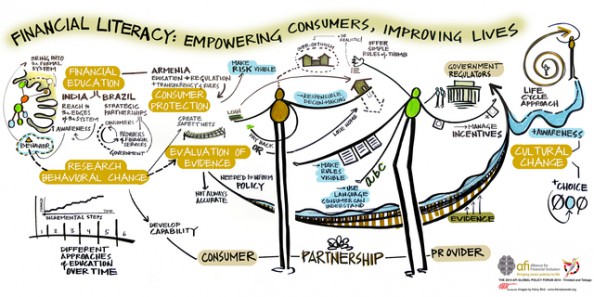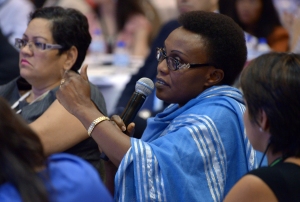Eliki Boletawa

2014 GPF participants discuss financial literacy during the Financial literacy: Empowering consumers, improving lives session in Trinidad and Tobago last September.
There is growing recognition that financial literacy has an important role to play in financial inclusion. Financial literacy is defined in different ways, but usually taken to mean the knowledge and understanding of personal finance concepts and the skills, motivation and confidence to make informed financial choices, and participate in economic life. A financially literate person will understand how to use financial products to meet their own financial goals, which may be very simple, like ‘a safe way to pay my bills’, or more complicated: ‘protecting my family if I get sick’, or ‘borrowing money to start a business’. They will use products with confidence, but be aware of scams and other risks, and know where to go for help and advice.
In the developing world, people are excluded from formal financial services for many reasons. One common issue is that banks use jargon, or even fail to provide marketing and product information in local languages. People do not understand what is on offer, and what they do not understand they do not trust. So they keep their money at home, or use the informal financial services with which they are familiar.
As the OECD has found, there is a correlation between financial literacy and financial inclusion [1]. This suggests financial education programs could be a good way of encouraging take-up of formal financial products. These programs will not do the trick on their own. The right products still have to be available at a fair price, and widely accessible. Consumer protection regulation is also needed to prevent people losing their money, being ‘missold’ products and to increase trust in the financial system.
This was the broad conclusion of the session on Measuring and Assessing Financial Capability: Practitioners share studies and findings at the 2014 Global Policy Forum (GPF) held in Trinidad and Tobago in September, which among other topics gave policymakers and practitioners the opportunity to share ideas on financial education and its links with inclusion and consumer protection. In the session on ‘Empowering Consumers, Improving Lives’, it was suggested that the role of the regulator should be to: (a) create awareness of the financial system; (b) educate consumers on their rights; and (c) provide consumer protection in a structures financial system.

A graphic facilitation output from the Financial literacy: Empowering consumers, improving lives session at the 2014 GPF.
The Reserve Bank of India (RBI) gave an example of its practical ‘financial literacy camps’, which help people understand how and where to save or borrow, and how to open an account. With these, it linked 95 percent of the target population to the financial system. For Brazil and Armenia, the central banks both set out how they are using financial education together with consumer protection, with the aim of increasing financial inclusion.
Although many initiatives are new, attendees were fairly optimistic that financial education initiatives were having a significant impact on consumer behavior: although at the GPF session only 16 percent ‘strongly agreed’ this to be the case, just over half agreed ‘somewhat’, with one third disagreeing.
In a session on measurement, a representative of the OECD emphasized the need to monitor, evaluate and address data gaps. The World Bank set out how measurement of financial literacy has developed over the past few years, more recently attempting to capture the external socioeconomic and environmental factors that influence decision-making, as well as measuring knowledge and understanding. The ‘wantok’ system in Papua New Guinea was highlighted as an example: here there is a social obligation to help those in the same village or town who are suffering financially. This inhibits the ability to save.
The Child Youth Finance International speaker reinforced this message by emphasizing the need to build social skills and self-esteem alongside the ‘knowledge’ aspects of financial literacy.

A 2014 GPF participant asks a question during the Financial literacy: Empowering consumers, improving lives session.
Speakers in the session drew a distinction between ‘process’ and ‘impact’ evaluation. The former is about how programs can be adjusted and developed in the light of feedback; the latter about how well a program meets its goals. In measuring impact, some studies have tracked the behavior of individuals over time, others have used a control group. The session ended with some examples of successful approaches, including the benefits of simple messages, and the use of ‘edutainment’. Finally, the audience voted on whether the money policymakers spend on financial education is well spent. Approximately two thirds said ‘yes’.
So, what are the conclusions? National strategies for financial education need clear goals, and to be targeted at the groups which will benefit most. There may be other ways of achieving the goals: sometimes regulation may be more efficient; or incentives, for example matched funding to save. Equally, the empowerment arising from increased financial literacy may have benefits that go beyond the original goals. These are complex issues for policymakers and practitioners, and underline the need to monitor and evaluate. But across the world, the costs of financial illiteracy and financial exclusion are too great to ignore.
Notes
1. Atkinson, A. and Messy, F. (2013), working paper “Promoting Financial Inclusion through Financial Education: OECD/INFE Evidence, Policies and Practice”, OECD Working Papers on Finance, Insurance and Private Pensions, No. 34, OECD Publishing.
ABOUT THE AUTHOR
Eliki Boletawa is the Team Leader, Policy Working Group Management, at the Alliance for Financial Inclusion (AFI). Follow Eliki on Twitter at: @pasifika_eb.



 About
About
 Online
Online
 Data
Data





















